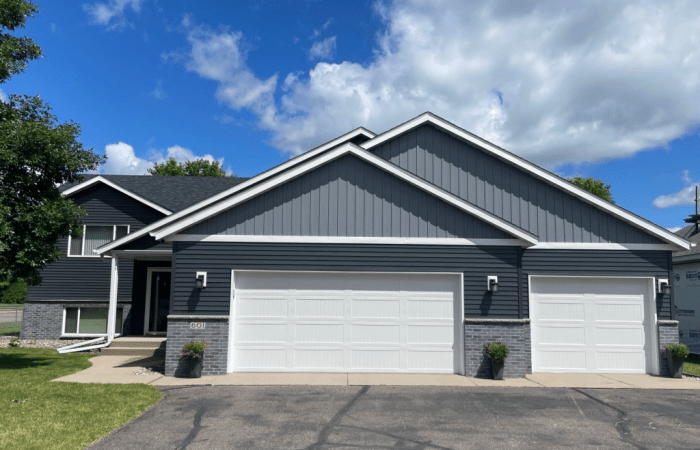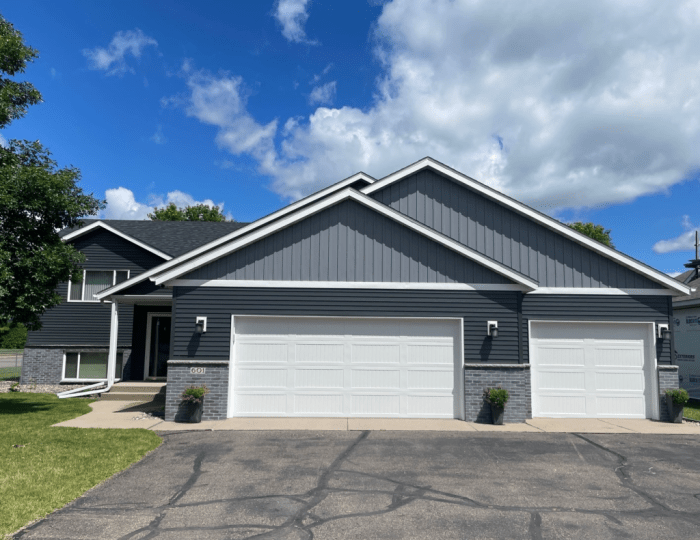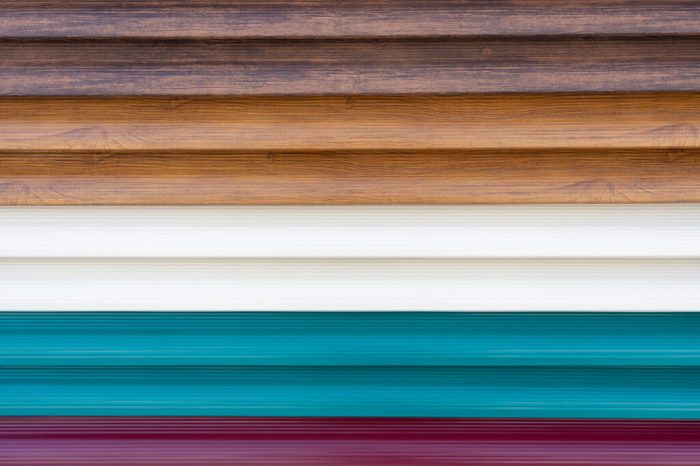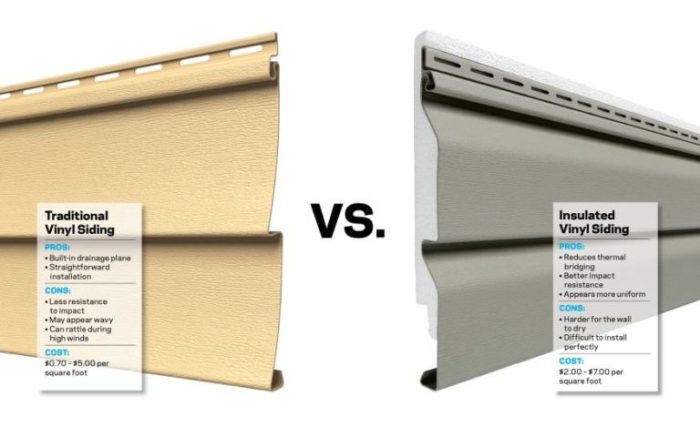Cost of Metal Siding vs Vinyl A Homeowners Guide

Cost of metal siding vs vinyl: Choosing the right siding for your home is a big decision, impacting both your wallet and your home’s curb appeal. This guide breaks down the costs—from initial materials to long-term maintenance—helping you make an informed choice. We’ll explore the price differences between various metal types (aluminum, steel, zinc) and vinyl grades, factoring in installation, lifespan, and even energy efficiency. Get ready to weigh the pros and cons of each option!
Understanding the total cost involves more than just the upfront price tag. Labor, maintenance, and eventual replacement all play a crucial role. This comparison considers all these factors to give you a comprehensive view, helping you determine which siding best fits your budget and long-term goals. We’ll even touch on aesthetic considerations and how they influence the overall cost.
Initial Costs
Choosing between metal and vinyl siding involves a significant upfront investment. Understanding the material costs is crucial for budgeting your home improvement project. This section breaks down the price differences between metal and vinyl siding for a typical 1500 sq ft house, considering various factors affecting the overall expense.
Material Price Comparison for a 1500 sq ft House
The price of siding varies greatly depending on the material and its quality. While precise pricing fluctuates with market conditions and location, we can provide a reasonable estimate to illustrate the cost differences. Remember that these are averages and actual costs may vary based on your specific needs and location. Professional installation costs are not included in these figures.
| Material Type | Price per Square Foot | Total Material Cost (1500 sq ft) | Notes on Quality/Durability |
|---|---|---|---|
| Aluminum Siding (Basic) | $3 – $5 | $4,500 – $7,500 | Lightweight, relatively inexpensive, but susceptible to dents and scratches; lower durability compared to steel. |
| Steel Siding (Standard) | $5 – $8 | $7,500 – $12,000 | Stronger and more durable than aluminum, offers better protection against damage; more resistant to extreme weather conditions. |
| Zinc Siding (Premium) | $10 – $15 | $15,000 – $22,500 | Extremely durable and long-lasting; self-healing properties; aesthetically unique with a naturally weathering patina. Significantly higher initial cost. |
| Vinyl Siding (Basic) | $2 – $4 | $3,000 – $6,000 | Affordable, easy to install; comes in a variety of colors and styles; lower durability and prone to damage from impact. |
| Vinyl Siding (Premium) | $4 – $7 | $6,000 – $10,500 | Improved durability and thicker material compared to basic vinyl; better resistance to fading and impact damage; more realistic wood-grain textures available. |
Installation Costs

Source: tonyslifetimeexteriors.com
Getting your new siding installed involves more than just the materials; labor costs are a significant part of the overall expense. The price you pay for installation will depend on several factors, and understanding these will help you budget effectively. This section breaks down the labor costs for both metal and vinyl siding, highlighting the differences in expertise needed and potential challenges that can impact the final bill.
Installation costs for metal and vinyl siding vary considerably. While vinyl is generally considered easier to install, the overall project cost can still be substantial, influenced by factors like house size, the complexity of the job (e.g., intricate trim work, multiple angles), and regional labor rates. Metal siding, requiring more specialized skills and tools, usually commands higher labor fees.
Labor Costs and Skill Levels
Labor costs for vinyl siding installation typically range from $2 to $8 per square foot, while metal siding installation can range from $4 to $12 per square foot or more. These are broad estimates, and the actual cost can fluctuate significantly based on geographic location. For example, labor costs in urban areas with high demand tend to be higher than in rural areas. A larger, more complex home with many angles, dormers, or intricate trim details will also naturally drive up the labor costs compared to a simpler, smaller structure. The condition of the existing siding also matters; removing old, damaged siding adds to the labor time and expense.
Vinyl siding installation generally requires less specialized skill than metal siding. While basic carpentry and construction knowledge are helpful, many contractors can handle vinyl installation with moderate training. However, even with vinyl, improper installation can lead to issues like leaks or warping, requiring costly repairs.
Metal siding installation demands more expertise. Working with metal requires specialized tools and knowledge of safe handling procedures. Improper installation can result in damage to the metal panels, leading to expensive replacements. Furthermore, the precise cutting and fitting required for metal siding necessitates a higher level of skill and precision.
Installation Timelines
The time required to install siding depends on several factors, making precise predictions difficult. However, we can compare the typical timelines for both materials.
- Vinyl Siding: A typical installation for a medium-sized house might take 1-3 days, though larger or more complex projects could take longer. Weather delays can significantly impact the schedule, as rain can halt progress. Material availability is generally less of a concern with vinyl than with metal, but unforeseen delivery delays are still possible.
- Metal Siding: Metal siding installations often take longer due to the more intricate work involved. A medium-sized house could require 3-7 days or more. Weather delays are equally significant, and material availability can be a bigger factor, as certain metal types or colors might have longer lead times.
Long-Term Costs
Choosing between metal and vinyl siding involves considering not just upfront costs, but also the long-term expenses associated with maintenance and repairs. Both materials have different lifespans and require varying levels of upkeep, impacting your overall budget over the years. Understanding these differences will help you make a more informed decision.
Maintenance and Repair Needs
Over a 20-year period, you’ll find that metal and vinyl siding require different maintenance approaches. Metal siding, while durable, is susceptible to scratches and dents, particularly in areas prone to hail or impacts from flying debris. Vinyl siding, on the other hand, is more resistant to dents but can fade, crack, or warp under extreme temperature fluctuations or prolonged sun exposure. Regular cleaning is essential for both to maintain their appearance and longevity.
Cleaning Requirements and Repair Scenarios, Cost of metal siding vs vinyl
Metal siding typically only needs occasional cleaning with a pressure washer and mild detergent to remove dirt and debris. More significant cleaning might be needed after a storm. Repairs for metal siding generally involve patching dents or replacing damaged sections, which can be costly depending on the extent of the damage. Vinyl siding also benefits from periodic cleaning, but a gentler approach is recommended to avoid scratching the surface. A soft brush and mild soap solution are usually sufficient. Repairs for vinyl siding often involve replacing damaged panels, which can be less expensive than metal repairs but still add up over time.
Cost Comparison of Repairs
Damage to both metal and vinyl siding can range from minor scratches to significant structural damage. For metal siding, a small dent might be easily repaired with a dent puller, while a large dent or puncture may require panel replacement. Scratches can often be touched up with paint. Vinyl siding damage often manifests as cracks, warping, or fading. Cracks and warping often necessitate panel replacement, while fading is typically less costly to address, perhaps with a specialized vinyl cleaner or a repaint if allowed by the manufacturer.
Maintenance and Repair Cost Comparison
| Siding Type | Maintenance Frequency | Average Annual Maintenance Cost | Major Repair Costs (Examples) |
|---|---|---|---|
| Metal | Annual cleaning; occasional inspections | $50 – $150 | Panel replacement ($100 – $500 per panel); dent repair ($50 – $200 per dent) |
| Vinyl | Annual cleaning; occasional inspections | $25 – $75 | Panel replacement ($25 – $100 per panel); repair of cracks/warping (varies greatly depending on the extent of damage) |
Lifespan & Replacement Costs
Choosing between metal and vinyl siding involves considering not only upfront costs but also the long-term implications, including lifespan and eventual replacement. Understanding these factors will help you make a more informed and financially responsible decision. Both materials offer significant longevity, but their lifespans and associated replacement costs differ considerably.
Metal and vinyl siding offer different lifespans, influenced by several factors. While metal generally outlasts vinyl, environmental conditions and maintenance practices play a significant role in determining the actual service life of either material.
Metal Siding Lifespan and Replacement Costs
Metal siding, typically aluminum or steel, boasts a remarkably long lifespan. Under normal conditions, it can easily last 40 to 50 years, and with proper maintenance, even longer. Factors impacting its lifespan include exposure to harsh weather (extreme temperature fluctuations, heavy snowfall, or coastal salinity), the quality of the initial installation (poor installation can lead to premature damage), and the presence of corrosive substances in the environment. Replacing metal siding involves significant labor costs due to the material’s durability. Removing the old siding can be challenging, and proper disposal of the metal is crucial for environmental reasons. Expect to pay a premium for labor, material costs (new siding, fasteners, and trim), permit fees (if required), and waste removal. A complete replacement could cost anywhere from $8,000 to $20,000 or more, depending on the house size, material choices, and regional labor rates. For example, a large two-story home in a high-cost area might fall on the higher end of this range, while a smaller home in a more affordable region might be closer to the lower end. The environmental impact of replacing metal siding is relatively low compared to vinyl. Metal is recyclable, reducing landfill waste, and its production, while energy-intensive, often uses recycled materials.
Vinyl Siding Lifespan and Replacement Costs
Vinyl siding generally lasts 20 to 30 years, though its lifespan can be shorter depending on the quality of the product and exposure to extreme weather conditions such as intense sunlight (leading to fading and brittleness) and hailstorms (causing damage). Poor installation can also significantly reduce its lifespan. Replacing vinyl siding is generally less expensive than replacing metal siding due to easier removal and installation. However, the disposal of vinyl siding presents a greater environmental challenge. While some vinyl can be recycled, the process is not widespread, and much of it ends up in landfills. The cost of replacing vinyl siding, including labor, materials, permits, and waste disposal, typically ranges from $5,000 to $15,000, depending on factors similar to those affecting metal siding replacement costs. A smaller home in a lower-cost area might fall at the lower end of this range, whereas a larger home in an area with higher labor costs might cost closer to the upper end. The environmental impact is higher due to the non-biodegradable nature of vinyl and its reliance on fossil fuels during manufacturing.
Environmental Impact Comparison
The environmental impact of siding replacement extends beyond disposal. The manufacturing processes of both materials consume energy and resources. Metal siding’s production is more energy-intensive, but its recyclability mitigates this impact to some extent. Vinyl siding’s production relies heavily on fossil fuels, and its limited recyclability contributes significantly to landfill waste. Choosing recycled materials for either type of siding can help lessen the environmental footprint. Proper disposal through recycling programs minimizes the negative environmental impact. In summary, while metal siding boasts a longer lifespan, vinyl siding is initially cheaper to replace. However, the environmental impact of vinyl’s disposal is more significant than that of metal.
Aesthetic Considerations & Customization

Source: alpinesheetmetalsystems.com
Choosing between metal and vinyl siding involves more than just durability and cost; aesthetics play a significant role in your home’s curb appeal and overall value. The range of colors, styles, and customization options available for each material can dramatically impact the final look and, consequently, the project’s total cost.
Metal and vinyl siding offer diverse aesthetic options, but their customization capabilities differ significantly. Understanding these differences is crucial for making an informed decision that aligns with your vision and budget.
Color and Style Options
Both metal and vinyl siding come in a wide array of colors and styles. Vinyl siding typically offers a broader palette of colors, often including more subtle and nuanced shades. Metal siding, while offering a strong selection, might have fewer choices in certain finishes like wood-grain effects. However, metal siding often excels in mimicking the look of other materials, such as cedar shake or stone, with impressive accuracy. The choice of color and style directly impacts the price; more specialized colors or textures, such as those mimicking natural materials, usually command a premium for both materials. For example, a custom-mixed color in vinyl might cost more than a standard shade, and a metal siding panel designed to replicate wood shakes will likely be pricier than a simple smooth panel.
Customization Options
Vinyl siding generally offers more straightforward customization through accessories. A wide range of trim pieces, corner boards, and decorative accents are readily available to complement the main siding panels. Metal siding, while offering similar accessories, can sometimes require more specialized fabrication or sourcing for unique designs or intricate trim work. For instance, creating a custom-shaped metal accent might involve additional costs for specialized cutting and fabrication, unlike vinyl, where pre-made options are more common. The ease of installation also influences customization; vinyl’s flexibility makes it easier to work with for intricate designs, whereas metal’s rigidity might require more expertise and potentially increase labor costs for complex installations.
Pros and Cons of Each Material Regarding Aesthetic Appeal and Design Flexibility
Let’s summarize the aesthetic pros and cons of each siding type:
Vinyl Siding
- Pros: Wide range of colors and styles readily available; extensive selection of trim and accessories; generally easier to install and customize, leading to potentially lower labor costs; often more affordable upfront for complex designs.
- Cons: Can appear less durable or less sophisticated than metal; color options may fade over time; less resistant to extreme weather conditions compared to metal, potentially impacting long-term aesthetic appeal; limited ability to replicate certain high-end looks.
Metal Siding
- Pros: Can mimic high-end materials like wood or stone effectively; durable and resistant to fading and damage; offers a modern and sleek aesthetic; longer lifespan, maintaining its appearance for many years.
- Cons: Fewer color options in some finishes; can be more expensive upfront, especially for complex designs or custom fabrication; installation can be more challenging and may require specialized skills, leading to higher labor costs; may dent or scratch more easily than vinyl.
Insulation & Energy Efficiency
Choosing between metal and vinyl siding often involves considering more than just aesthetics; energy efficiency plays a significant role in long-term costs. Both materials offer varying degrees of insulation, directly impacting your heating and cooling bills. Understanding these differences can help you make an informed decision that aligns with your budget and environmental concerns.
Metal siding, while not inherently an insulator, can contribute to better energy efficiency through its reflective properties. Its surface reflects solar radiation, reducing the amount of heat absorbed by the building’s exterior, especially during summer months. This reflective quality can translate into lower cooling costs. Vinyl siding, on the other hand, doesn’t offer the same level of reflectivity. However, certain vinyl siding products incorporate insulation features, such as foam backing, which significantly improves their thermal performance.
Insulation Properties and Energy Cost Impact
Metal siding’s energy efficiency advantage primarily stems from its reflectivity. Studies have shown that homes with reflective siding can experience a noticeable reduction in cooling loads, potentially saving homeowners hundreds of dollars annually, depending on climate and building size. For example, a study conducted by the Lawrence Berkeley National Laboratory found that homes with light-colored, reflective roofs and siding experienced a 10-20% reduction in cooling energy consumption compared to homes with dark-colored materials. While vinyl siding might not reflect solar radiation as effectively, the addition of insulated foam backing can compensate for this, making it a viable alternative in colder climates. The insulation value (R-value) of the foam backing is the key factor in determining its energy-saving potential. A higher R-value indicates better insulation.
Installation Method and Energy Efficiency
The method of installation—over existing siding or during new construction—significantly impacts the overall energy efficiency of both metal and vinyl siding. Installing siding over existing siding might leave gaps or air pockets, reducing the effectiveness of any insulation properties. In contrast, new construction allows for a more seamless and airtight installation, maximizing the insulation potential of either siding type. In new construction, using appropriate insulation beneath the siding is crucial. For metal siding, this could involve using rigid foam insulation boards, while vinyl siding installations often benefit from foam-backed panels. Proper installation is paramount regardless of the siding material; poor installation can negate any insulation benefits. For example, inadequate sealing around windows and doors can create drafts, negating the energy savings achieved through improved siding insulation.
Long-Term Energy Savings
Predicting precise long-term energy savings is challenging without specific details about the home, climate, and energy costs. However, we can illustrate potential savings. Let’s consider a hypothetical scenario: a 2,000 square foot home in a region with hot summers and mild winters. If we assume that reflective metal siding reduces cooling costs by 15% and the average annual cooling bill is $1,500, the annual savings would be $225. Over 20 years, this equates to $4,500. If we compare this to vinyl siding with foam backing offering a 10% reduction in heating and cooling costs, assuming a combined annual heating and cooling bill of $2,000, the annual savings would be $200, totaling $4,000 over 20 years. These are simplified examples; actual savings will vary depending on several factors. It’s important to consult with energy efficiency professionals for personalized estimates based on your specific location and home characteristics.
Last Recap

Source: sidingauthority.com
Ultimately, the “best” siding—metal or vinyl—depends on your individual needs and priorities. While vinyl often offers a lower initial investment, metal boasts superior durability and longevity. Carefully consider the long-term costs, including maintenance and replacement, alongside your aesthetic preferences and energy efficiency goals. This guide provides a solid foundation for making a well-informed decision that will enhance your home’s value and curb appeal for years to come. Remember to get multiple quotes from reputable contractors before committing to a project of this size.
Top FAQs: Cost Of Metal Siding Vs Vinyl
Can I install siding myself?
While DIY is possible for vinyl, professional installation is highly recommended for metal siding due to its complexity and the need for specialized tools and safety precautions. Attempting a DIY metal siding installation could lead to costly mistakes.
What about insurance coverage for siding damage?
Most homeowner’s insurance policies cover damage to siding from events like hail or strong winds. However, normal wear and tear is usually not covered. Check your specific policy for details.
How does climate affect siding choice?
Metal siding excels in harsh climates due to its durability and resistance to extreme temperatures and moisture. Vinyl can be susceptible to damage in extremely hot or cold conditions.
What are financing options for siding replacement?
Many home improvement stores and contractors offer financing plans, including loans and credit options. Shop around for the best rates and terms.
How long does the installation process take?
Installation time varies depending on the house size and complexity, but generally, vinyl siding takes less time to install than metal siding.
Comments are closed.